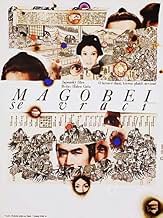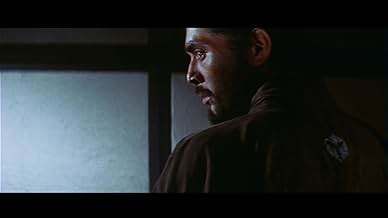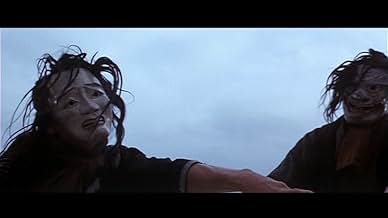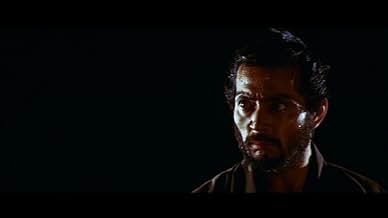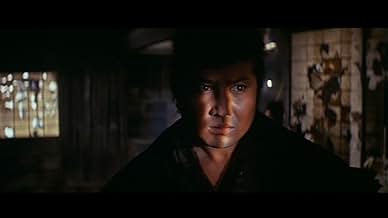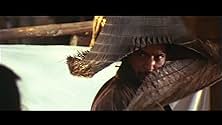IMDb रेटिंग
7.6/10
2.8 हज़ार
आपकी रेटिंग
अपनी भाषा में प्लॉट जोड़ेंA guilt-haunted samurai warrior attempts to prevent a massacre from taking place.A guilt-haunted samurai warrior attempts to prevent a massacre from taking place.A guilt-haunted samurai warrior attempts to prevent a massacre from taking place.
- पुरस्कार
- 2 जीत और कुल 1 नामांकन
फ़ीचर्ड समीक्षाएं
After reading all the raves about this movie I was looking forward to finally watching it. I have to admit to being somewhat let down. Mind you it is a good movie with Nakadai putting in a great performance as a haunted samurai. Maybe I have seen too many samurai or movies from the east but the story seems formulaic for me (I am also watching it over 40yrs since it was made and the movie is older then I am). I still give this movie a 7 rating as it is a good movie but there definitely are better ones. Note: I watched Goyokin after The Sword of Doom. Nakadai's performance is better in this movie but I enjoyed The Sword of Doom more as a whole.
"Goyokin" is passionate, poetic, beautiful, colorful, thrilling, and brilliantly-filmed. It would be an understatement to say that "Goyokin" is one of the best-looking films I've seen in a long time. Hideo Gosha is one of the most under-appreciated Japanese directors and I say this purely on the strength of this one film because it is a true masterpiece.
"Goyokin" has a sense of theatricality about it that fits better than even many of Kurosawa's films. "Rashomon" for instance features performances completely unsuitable for the film's general mood (in my opinion), but in "Goyokin" the nature of the film fits perfectly with the mood and atmosphere Gosha creates. It's almost operatic in many ways, most noticeably so in the exquisitely-filmed sword fighting scenes. The story itself is also fitting of an Opera or an ancient Greek or Roman tragedy. In the tradition of many chambara films the film is reminiscent in sensibility to a revisionist Western, which can either come off as interesting or forced and in this case reminded me of some of the great American and Italian Westerns that came after the genre's popularity started dying.
Gosha's work here is spectacular. The selection of shots and his coordination with the camera operator are brilliant. The cinematography by Kozo Okazaki displays a fine and mature understanding of the mechanics of photography for film and captures the landscape of the film brilliantly. All the acting is good but Tatsuya Nakadai is truly memorable in the lead role.
I find it exceptionally hard to write extensively about movies I truly love because I find it hard to articulate my thoughts. I'm not sure I have much to say about this film since it struck me on such an emotional level and because it only matters that it is a passionate, poetic, and stunningly well-filmed movie that stands as my favorite movie in the genre quite easily and has immediately become one of my all-time favorites.
10/10
"Goyokin" has a sense of theatricality about it that fits better than even many of Kurosawa's films. "Rashomon" for instance features performances completely unsuitable for the film's general mood (in my opinion), but in "Goyokin" the nature of the film fits perfectly with the mood and atmosphere Gosha creates. It's almost operatic in many ways, most noticeably so in the exquisitely-filmed sword fighting scenes. The story itself is also fitting of an Opera or an ancient Greek or Roman tragedy. In the tradition of many chambara films the film is reminiscent in sensibility to a revisionist Western, which can either come off as interesting or forced and in this case reminded me of some of the great American and Italian Westerns that came after the genre's popularity started dying.
Gosha's work here is spectacular. The selection of shots and his coordination with the camera operator are brilliant. The cinematography by Kozo Okazaki displays a fine and mature understanding of the mechanics of photography for film and captures the landscape of the film brilliantly. All the acting is good but Tatsuya Nakadai is truly memorable in the lead role.
I find it exceptionally hard to write extensively about movies I truly love because I find it hard to articulate my thoughts. I'm not sure I have much to say about this film since it struck me on such an emotional level and because it only matters that it is a passionate, poetic, and stunningly well-filmed movie that stands as my favorite movie in the genre quite easily and has immediately become one of my all-time favorites.
10/10
This is a special beast of a samurai film because of several things.
For starters it is often compared unfavorably to "Sword of Doom" (completely nihilist B&W psycho samurai also starring Tatsuya Nakadai as a clone of his Yojimbo character). Quite frankly, Goyokin is far superior in nuance, photography and character depth. It holds that edge and an inherent darkness that is exquisitely explored visually over most samurai films in existence: more poetic than Zatôyichi (2003, Kitano), better filmed and written than Sword of Doom (1966, Okamoto), less remote than Ran (1985, Kurosawa) and darker and deeper than Yojimbo (1961, also Kurosawa); the only samurai to best this is Seven Samurai.
Tatsuya Nakadai comes across as three-dimensional, which is a departure from most chambara film heroes, and tormented but eminently likable. Every character is given sufficient growth and motive. Masaru Sato gives us one of his finest scores ever (the other being that of Yojimbo). The photography defeats any samurai film that could possibly cross your mind (yes, even Ran and by a narrow margin Seven samurai's stark B&W beauty)! The fights have a sincere brutality and make the most of their environment... There is little else to add... well no maybe there is. Don't go in expecting pop-corn entertainment but rather something deeper more complex.
I've heard that Inagaki's Samurai trilogy was Japan's "Gone With the Wind", Red Beard it's "Titanic" and Seven Samurai its ultimate western... if so, "Goyokin" is its "Lawrence of Arabia"!
For starters it is often compared unfavorably to "Sword of Doom" (completely nihilist B&W psycho samurai also starring Tatsuya Nakadai as a clone of his Yojimbo character). Quite frankly, Goyokin is far superior in nuance, photography and character depth. It holds that edge and an inherent darkness that is exquisitely explored visually over most samurai films in existence: more poetic than Zatôyichi (2003, Kitano), better filmed and written than Sword of Doom (1966, Okamoto), less remote than Ran (1985, Kurosawa) and darker and deeper than Yojimbo (1961, also Kurosawa); the only samurai to best this is Seven Samurai.
Tatsuya Nakadai comes across as three-dimensional, which is a departure from most chambara film heroes, and tormented but eminently likable. Every character is given sufficient growth and motive. Masaru Sato gives us one of his finest scores ever (the other being that of Yojimbo). The photography defeats any samurai film that could possibly cross your mind (yes, even Ran and by a narrow margin Seven samurai's stark B&W beauty)! The fights have a sincere brutality and make the most of their environment... There is little else to add... well no maybe there is. Don't go in expecting pop-corn entertainment but rather something deeper more complex.
I've heard that Inagaki's Samurai trilogy was Japan's "Gone With the Wind", Red Beard it's "Titanic" and Seven Samurai its ultimate western... if so, "Goyokin" is its "Lawrence of Arabia"!
Goyokin is a hauntingly beautiful story of a Magobei Wakazaka a samurai turned to a drunk guilt ridden ronin after taking part in the slaughter of some innocent people because he was following orders from his brother in law in a plot to steal some official gold (Goyokin). When his brother in law decides to steal more gold and kill more people some assassins come for Magobei to silence him forever. This causes Magobei to throw down the bottle of sake and take up the sword once again. He decides to journey back to stop the slaughter and seek redemption.Gosha tells the classic story of a samurai and his giri-ninjo conflict, that is his struggle against following orders which is the way of the samurai, or doing what he believes is right. He uses his trademark crows as symbolic supernatural supervisors of karma and in such a way it eerily beautiful and unforgettable.
I saw this film in the late 1970s. It was called "Goyekin - The Emperor's Gold". As I watched our guilt-ridden hero return to fulfill his promise, really a threat, to punish his family if they repeated their crime. I still see the image of him striding along the beach with a conical hat pulled low. The shadow on his face made his eyes glow under the hat and the shot was taken with a telephoto through wispy beach grass. Completely memorable. Then the scene in the forest with the horsemen riding through. It looked like an ancient Japanese painting with hazy colors and an other-worldliness that was amazing. Then the concluding duel in the snow. Two brilliantly attired samurai dueling in a pure white, glistening environment. So many great images from one film!
The film itself is a pretty typical revenge film with some twists. When Tom Laughlin tried to redo it as a Mexican western,"The Master Gunfighter", it just fell flat. But the samurai movie has an entertaining plot and good action characters with beautiful settings. I think this film is a special case of cinematographic excellence. See it and enjoy the beauty.
The film itself is a pretty typical revenge film with some twists. When Tom Laughlin tried to redo it as a Mexican western,"The Master Gunfighter", it just fell flat. But the samurai movie has an entertaining plot and good action characters with beautiful settings. I think this film is a special case of cinematographic excellence. See it and enjoy the beauty.
क्या आपको पता है
- ट्रिवियाThis is the first Japanese feature film in Panavision.
- कनेक्शनFeatured in Trailer Trauma V: 70s Action Attack! (2020)
टॉप पसंद
रेटिंग देने के लिए साइन-इन करें और वैयक्तिकृत सुझावों के लिए वॉचलिस्ट करें
- How long is The Steel Edge of Revenge?Alexa द्वारा संचालित
विवरण
- चलने की अवधि2 घंटे 4 मिनट
- ध्वनि मिश्रण
- पक्ष अनुपात
- 2.35 : 1
इस पेज में योगदान दें
किसी बदलाव का सुझाव दें या अनुपलब्ध कॉन्टेंट जोड़ें


